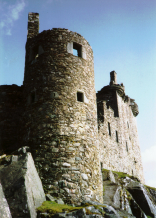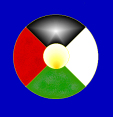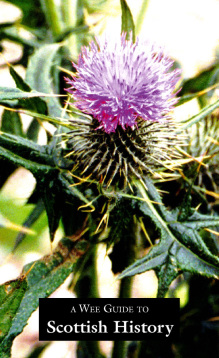The Wars of Independence
1289 Margaret, the Maid of Norway
Margaret, the Maid of Norway, was the next in line to the throne. She was the daughter of Margaret – daughter of Alexander III, who had died in 1283 – and the King of Norway.
It was agreed that Margaret, the Maid of Norway, should be brought to Scotland from Norway, and in the meantime the kingdom was to be ruled by six Guardians. In an attempt to avoid civil war, they asked Edward I of England – who had been friendly to the Scots – to help them. At the Treaty of Birgham, a marriage was arranged between Margaret and the son of Edward I of England, although this treaty stated that homage should not be paid to an English monarch, and all Scottish institutions should remain independent.
1290-96 Death of Maid of Norway & Balliol becomes King
On her way to Scotland, Margaret died, reportedly from sea sickness, having only got as far as Orkney.
One of the Guardians, Bishop Fraser, fearing civil war, then unwisely asked Edward I of England to choose a king from 13 claimants, including John Balliol and Robert Bruce, the grandfather of the future king. Edward summoned the claimants to Norham Castle – now a substantial ruin in Northumberland – first getting them to swear allegiance to him. Edward then chose John Balliol, who accepted the English king as his overlord, Superior and Lord Paramount of Scotland.
1295 Treaty with France: the Auld Alliance
John Balliol married Isabel de Warenne, and they had a son, Edward.
Balliol tried to restore royal authority, but was hampered by the interference of Edward of England, and the Bruces, who still had designs on the throne themselves. Edward I of England tried to provoke Balliol into defiance, and when in 1295 the Scots signed a treaty with France, England’s enemy, so beginning the Auld Alliance, Edward had the excuse he needed to crush the Scots once and for all.
1296 Edward I invades Scotland & the Battle of Dunbar
Balliol’s resistance against Edward I only stung the English king to act. An English army, said to number 35 000 men, invaded Scotland, and sacked Berwick – then a rich Scottish burgh – slaughtering 16 000 of its inhabitants: men, women and children.
A large but inexperienced Scottish army was heavily defeated by Edward at the Battle of Dunbar, and the English occupied much of Scotland, advancing all the way to Elgin. Balliol surrendered at Brechin, earning his nickname Toom Tabard – empty coat – and was stripped of his office.
Edward took over control of Scotland, installing English garrisons in many castles. He eventually returned to the south, taking with him the Stone of Destiny and Coronation Chair, on which the kings of Scots had been inaugurated, and many other treasures.
The Stone of Destiny was kept beneath the Coronation Chair in Westminster Abbey in England, but has been returned to Edinburgh Castle, after 700 years. Scone Palace stands on the site of the abbey from which the stone was taken.
Edward forced over 2000 nobles, churchmen and landholders to swear allegiance to him. The list of their names became known as The Ragman Roll, after the ragged look of all the different seals and ribbons.
1297-1305 William Wallace: Battles of Stirling Bridge & Falkirk
The English occupation was harsh and the Scots rose, led by William Wallace and Sir Andrew Moray. Wallace was a son of the laird of Elderslie, and his wife had probably been murdered by the English sheriff of Lanark. Wallace was a successful guerrilla leader, and was greatly admired by the general population, although much of the nobility viewed him with suspicion. This included the Bruces, who still wished to assert their own claim to the throne – Wallace supported Balliol.
In 1297 Wallace and Moray defeated a large English army at Stirling Bridge, where Hugh de Cressingham, Edward’s treasurer of Scotland, was skinned and turned into a saddle bag. Moray died soon afterwards, possibly from wounds received at the battle.
Wallace was knighted and became a Guardian, and ravaged the north of England. This prompted Edward into invading Scotland in 1298, and he crushed any Scottish resistance by defeating Wallace at the Battle of Falkirk. Many nobles fled the battle rather than fight on with Wallace.
Wallace left Scotland on a diplomatic mission to the continent, but when he returned was betrayed and captured by the English, then hanged, drawn and quartered in London in 1305. In killing Wallace so horribly, Edward I had only succeeded in creating a national hero.
1305-08 Robert the Bruce & the Wars of Independence
Robert the Bruce had a claim to the throne as a descendant of David, Earl of Huntingdon, brother of both William the Lyon and Malcolm the Maiden. Bruce was first married to Isabella of Mar, and it was through their daughter Marjorie that the Stewarts became kings. By his second wife, Elizabeth de Burgh, he had a son, David.
In 1306 Bruce agreed to meet John Comyn of Badenoch, who had a more direct claim to the throne, and was related to John Balliol. The Comyns were one of the most powerful families in Scotland, supported by the MacDougalls of Lorne, MacDowalls of Galloway, and Earl of Ross.
Bruce and Comyn met in a church at Dumfries to resolve their differences, but the two men argued and Comyn was stabbed to death by Bruce. Although Bruce was a hunted fugitive, and was excommunicated, he declared himself King of Scots at Scone in 1306. His small army was defeated at Methven, and then scattered at Dalry, and he had to flee the country. He lost more than these battles: three of his brothers, Nigel, Thomas and Alexander, were executed by the English; his sister, Mary, was hung from a cage at Roxburgh Castle; his sister and daughter Christine and Marjorie, along with his second wife, Elizabeth de Burgh, were imprisoned.
Luckily for Bruce, however, Edward I of England died in July 1307 at Burgh by Sands, just on the English side of the Border. Edward died berating his son to
ravage Scotland, but Edward II was not as ruthless or effective, and retreated to bury his father.
Bruce returned to Scotland and won battles at Loudoun Hill; the Pass of Brander, where he defeated the MacDougalls; in Galloway, where the MacDowalls were crushed; and at Inverurie, where he destroyed the power of the Comyns, and their allies, and wasted Buchan. The Earl of Ross submitted to Bruce. Other risings expelled the English garrisons from most Scottish castles, until only Stirling Castle was in the hands of the English. James Douglas, Neil Campbell, Angus Og MacDonald, and the High Stewards or Stewarts were among Bruce’s loyal supporters, all important families in the later history of Scotland.
It was Bruce’s policy to destroy castles so that they could not be held by the English. However, Bothwell, Dirleton, Caerlaverock and Kildrummy castles all
survive – in part – from before the Wars of Independence.
1314 Battle of Bannockburn
By 1314, only Stirling Castle – on its rock and still a vast fortress – was held by the English, and was besieged by the Scots. Edward II and a large army marched north to relieve the castle. On the eve of the battle, Henry de Bohun challenged Bruce to single combat, but Bruce clove de Bohun’s head with an axe. Although outnumbered three to one, the Scots won the Battle of Bannockburn, and many of the English were slaughtered or captured, although this was as much due to their bad tactics and poor leadership. The battle site is open to the public.
1320 Declaration of Arbroath
Battles continued and although the Scots had the best of
it, notably by defeating the English deep into England at the Battle of Byland, Edward II would not recognise Scotland’s independence – nor would the Pope. A Declaration, sealed by most of the nobles of Scotland, was drawn up at Arbroath Abbey, which urged the Pope to recognise Scotland as a free independent country, and to put pressure on the English to do the same.
1329 Death of Robert the Bruce & Accession of David II
Edward III finally recognised Scotland’s independence in 1328, the year before Bruce died, reportedly from leprosy, at Cardross, near Dumbarton. Bruce’s heart was removed from his body, and taken on a crusade to Granada by James Douglas, although it was eventually interred at Melrose Abbey. A lead casket was recently excavated from the Abbey, and is believed to contain Bruce’s heart. This act is commemorated by the heart on the Douglas coat of arms. The rest of Bruce’s body was buried at Dunfermline. David, his young son, was made king, but peace lasted for only a few years after Bruce’s death.
1332-41 Edward Balliol & the Battle of Halidon Hill
Edward, son of John Balliol, invaded Scotland, with help from Edward III and the English, and was made king after defeating a Scottish army at Dupplin Moor. David II was sent to France for safety.
Edward III of England was a much more able king than Edward II, and besieged Berwick, crushing a Scottish army at the Battle of Halidon Hill, near Berwick, in 1333. Although Edward Balliol was initially successful, he was eventually defeated by Andrew Moray the Regent, son of the victor of the Battle of Stirling Bridge, and had to flee Scotland in 1341.
1346-71 Battle of Neville’s Cross & the Treaty of Berwick
David II returned to Scotland, and led an invasion of England in support of the French, who were at war with the English – this was not the only time that the Auld Alliance would harm the Scots. The Scots were heavily defeated by the English at the Battle of Neville’s Cross in the north of England, and David was taken prisoner. David fought bravely, but in vain, although Robert the High Steward fled the battle.
Edward ravaged the south of Scotland in 1356, known as the Burnt Candlemas. However, in 1357 David was released after a ransom of 100 000 merks was agreed, although the Scots never paid most of the money.
David died in 1371 at Edinburgh Castle, without heir, although he was twice married: to Joan of England, who died in 1362; and to a former mistress, Margaret Logie. Although he hated the Stewarts, partly because of the cowardly action of Robert the High Steward, he could not prevent the succession to the throne of Robert II, son of Marjorie – daughter of Robert the Bruce – and Walter the High Steward. David reportedly would have offered the English king the throne if he had been allowed. The Stewarts were so named because they were the High Stewards of the kingdom, their original family name having been FitzAllan.
© Martin Coventry 2018









